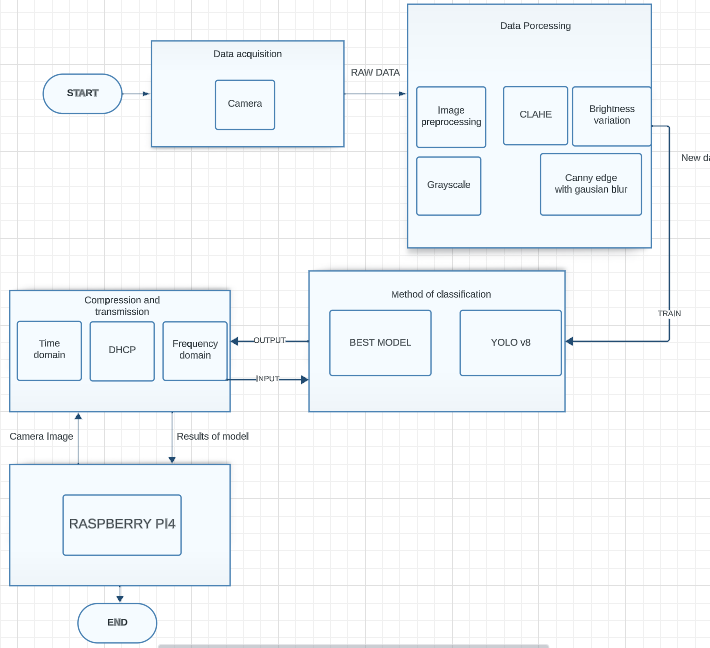Our project aims to implement an artificial vision system for a minesweeper robot, which will compete in the Minesweeper 2024 competition in Egypt. The artificial vision system leverages a combination of machine learning and deep learning techniques, encompassing data acquisition, image processing, and compression methods. Additionally, a Convolutional Neural Network (CNN) is employed for mine detection and classification. To approach the mines effectively, we employ techniques based on YOLOv8.
Landmines, concealed beneath the Earth's surface, pose a grave threat, claiming lives and causing grievous injuries, particularly among innocent civilians. These insidious devices have left a lasting legacy in conflict-ridden regions, hindering economic progress and devastating communities dependent on affected land. Current manual demining efforts are both perilous and time-consuming, requiring individuals to risk their lives dismantling these hidden killers. This project addresses the urgent need for advanced solutions to this humanitarian crisis by leveraging cutting-edge technology. Robots and autonomous systems offer a ray of hope, promising safe detection and efficient elimination of landmines. Initiatives like the "Minesweepers" competition and the "SEEKER" project champion technological innovation as the key to solving this global issue.The project employs computer vision methods to enhance mine detection capabilities. The Region Proposing Convolution Network (RPN) is integral in proposing regions of interest within images. Furthermore, end-to-end training streamlines the model, improving accuracy, reducing training time, and simplifying the process. The YOLO algorithm, incorporated in the SEKEER mine finder, is employed for metal mine detection, with the ability to predict bounding boxes and class probabilities for potential metal mines in collected images. This project's multifaceted approach underscores the importance of technological innovation in the fight against landmines, offering safer, more efficient, and expedited solutions for the detection and removal of these deadly devices.
Landmines are insidious devices concealed beneath the Earth's surface, designed to unleash deadly force upon contact with an unsuspecting person or vehicle. These concealed threats have cast a long shadow over past conflicts, leaving behind a legacy of minefields that persist long after hostilities have ceased.
The primary issue at hand is the relentless toll taken by landmines, claiming lives and inflicting grievous injuries upon civilians, including children, farmers, and entire communities whose livelihoods depend on the very land tainted by these silent killers. Moreover, the presence of landmines acts as a formidable barrier to economic progress, as it curtails access to cultivable land and vital natural resources. Manual demining operations, the current method of addressing this crisis, are perilous, resource-intensive, and time-consuming. These operations entail courageous individuals risking their lives to disarm individual mines.
The imperative to address this critical humanitarian challenge is underscored by the urgency to develop advanced technologies and pioneering solutions. Robots and autonomous systems emerge as a beacon of hope, promising both the safe detection and efficient elimination of landmines.
Within this context, initiatives like the "Minesweepers" competition and the "SEEKER" project have come to the fore, dedicated to fostering technological innovation as the cornerstone of addressing this pressing global crisis.
In response to the critical need for an autonomous vehicle capable of effectively detecting and collecting surface metallic mines, we present a comprehensive solution that addresses this specific challenge. Our approach involves the implementation of a deep learning model, strategically bolstered by cutting-edge computer vision techniques, dedicated to the precise detection and efficient retrieval of metallic mines within a defined geographical area.
It's important to emphasize a deliberate limitation in our solution: we focus exclusively on the essential tasks of mine detection and collection, deliberately refraining from the intricate process of mapping the entire terrain. This selective focus streamlines the system, enabling it to swiftly and accurately identify metallic mines at the surface level while providing the means to collect them safely.
By recognizing and adhering to this limitation, we aim to deliver a highly specialized solution that optimizes the efficiency and effectiveness of mine clearance operations. Our approach ensures that the critical steps of mine detection and collection are addressed with the utmost precision and speed, contributing to the overall safety of landmine-affected regions, without the added complexity of terrain mapping.
This is the tentative diagram:

What did you learn while building this project? What challenges did you face and how did you overcome t
Clone the project
git clone https://github.com/97hackbrian/Seeker_ComputerVision.gitGo to the branch you are interested in main Train TrainGray embedded TestTakeData
git switch nombre_de_la_rama
cd my-projectInstall dependencies
conda env create -f environment.yml
pip install -r requirements.txt
To run this project, you will need to add the following environment variables to your .env file
API_KEY
ANOTHER_API_KEY
If you have any feedback, please reach out to us at brayan.duran.t@ucb.edu.bo
